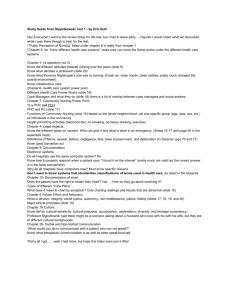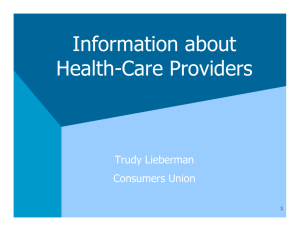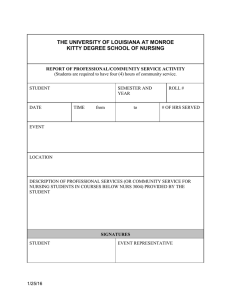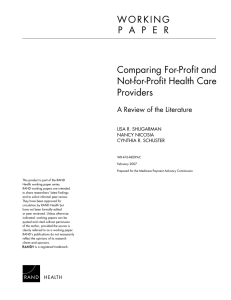W O R K I N G Comparing For-Profit and
advertisement
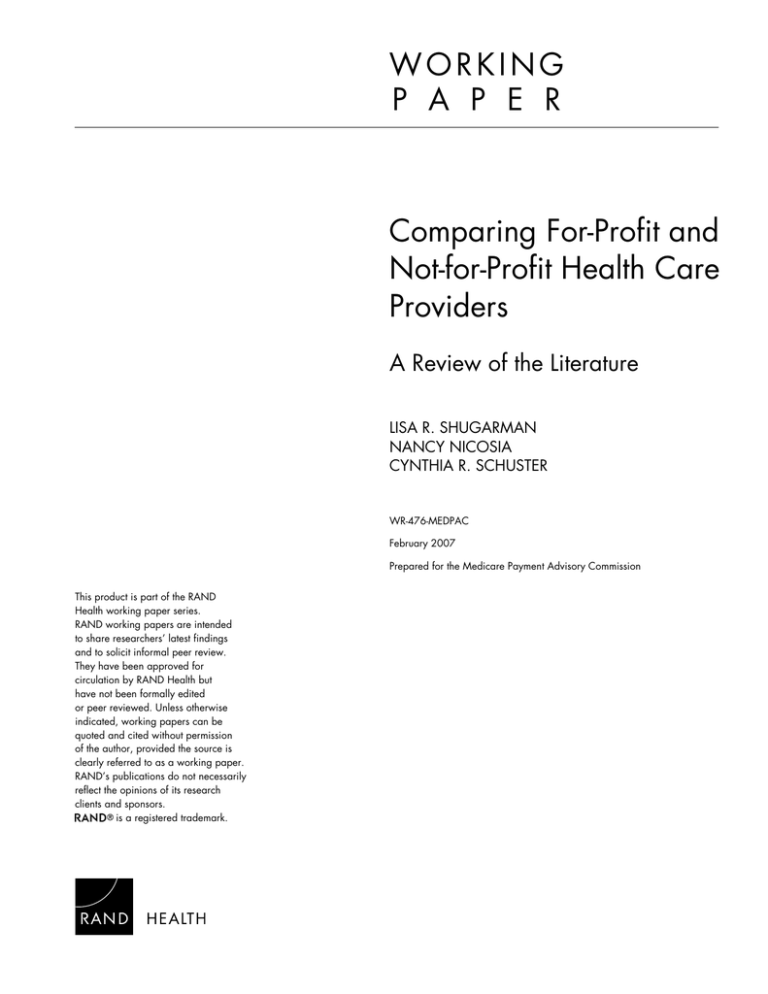
WORKING P A P E R Comparing For-Profit and Not-for-Profit Health Care Providers A Review of the Literature LISA R. SHUGARMAN NANCY NICOSIA CYNTHIA R. SCHUSTER WR-476-MEDPAC February 2007 Prepared for the Medicare Payment Advisory Commission This product is part of the RAND Health working paper series. RAND working papers are intended to share researchers’ latest findings and to solicit informal peer review. They have been approved for circulation by RAND Health but have not been formally edited or peer reviewed. Unless otherwise indicated, working papers can be quoted and cited without permission of the author, provided the source is clearly referred to as a working paper. RAND’s publications do not necessarily reflect the opinions of its research clients and sponsors. is a registered trademark. EXECUTIVE SUMMARY This report summarizes a literature review examining the relationship between ownership status and facility costs. Our systematic review covered hospitals, nursing homes, and dialysis centers as well as four post-acute care settings: Skilled Nursing Facilities (SNFs), Long-Term Care Hospitals (LTCHs), Institutional Rehabilitation Facilities (IRFs), and Home Health Agencies (HHAs). We examined journals, annals, published studies from public and private health services research organizations, and conference papers and presentations for this review, focusing on those published in the last ten years (1996-2006). As part of this review, we responded to the questions derived from the original Statement of Work provided by MedPAC. Specifically, we addressed the following inquiries: 1) What are the most commonly used forms of regression analysis used to model facilitylevel per case costs? What are the strengths and limitations of these models? 2) What are the most widely used standardized costs per case measures? What are the strengths and limitations of these measures? 3) What are the most widely used severity adjusters? What are the strengths and limitations of these adjusters? 4) What assumptions about providers as economic actors (profit maximizers, etc.) are customarily part of the analysis of providers’ costs? 5) Which variables explained significant differences between for-profit and not-for-profit providers’ costs? In addition to addressing these issues, we also reviewed the different types of model specifications in terms of the included covariates, the relationship of these covariates to costs, and the strengths and limitations of these measures. In total, we identified 33 papers that met our inclusion criteria, from which we abstracted information about 38 models of costs. The majority (23 papers presenting 27 models) focused on acute-care hospitals as the unit of analysis. Nursing homes were the unit of analysis in eight articles presenting 9 models. We also identified one paper focusing on costs in dialysis centers. Only one paper was identified that focused on a post-acute care setting (HHAs). No publications were found for the other post-acute care settings (SNFs, LTCHs, IRFs). The reviewed papers provide conflicting evidence on whether and how for-profit ownership affects hospital costs, but provide consistent evidence that costs are lower among forprofit nursing homes. This review summarizes a number of factors that might affect the findings including: the approach, functional form, relevant assumptions regarding errors and efficiency, assumptions regarding behavior, the specification of output, input prices, quality, case mix, and the included provider and market controls. The report also discusses other relevant factors associated with the approach including the use of panel vs. cross-sectional analyses, and the use of state vs. national samples. To some extent, the conflicting findings for hospitals may result from differences in methodology: the approach (i.e., statistical modeling using multivariate regression, stochastic frontier regression, etc.), the functional form (e.g., translog, Cobb-Douglas, etc.), the iv specification and the data used to analyze the relationship of for-profit ownership to costs. There was no consistent pattern in the results for profit status by the analytic approach or by the functional form used. There was substantial variation in the specification (i.e., included covariates) in the hospital models although we did not detect a strong relationship between how well-specified a model was and the conclusion of the study effect of profit status on costs. Cross-sectional analyses of hospitals were more likely to yield inconsistent results than panel data; state-level data were more likely to yield a significant negative finding than national-level data. Multivariate regression was also the primary approach for analysis of the nursing home industry. Still, there was no particular relationship between approach and functional form for nursing homes. There was also less variation in specification among nursing home models. Nursing home models favored state-level cross-sectional analyses over panel data methods and national data. In this report, we first provide a brief background on the issues related to profit status and provider costs and describe the objectives of this literature review. We then discuss the methods used to identify the literature and the results from our review efforts. Additional results are shared, organized primarily around the five questions proposed in the Statement of Work provided by MedPAC. Finally, we provide a summary and a discussion of the implications of these findings for future work on the relationship between profit status and provider costs, particularly in the post-acute care setting. v
